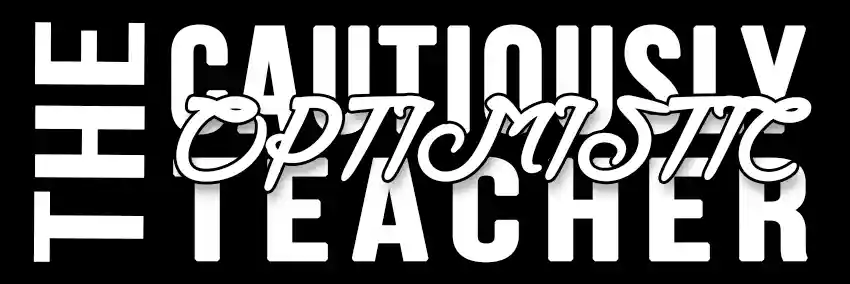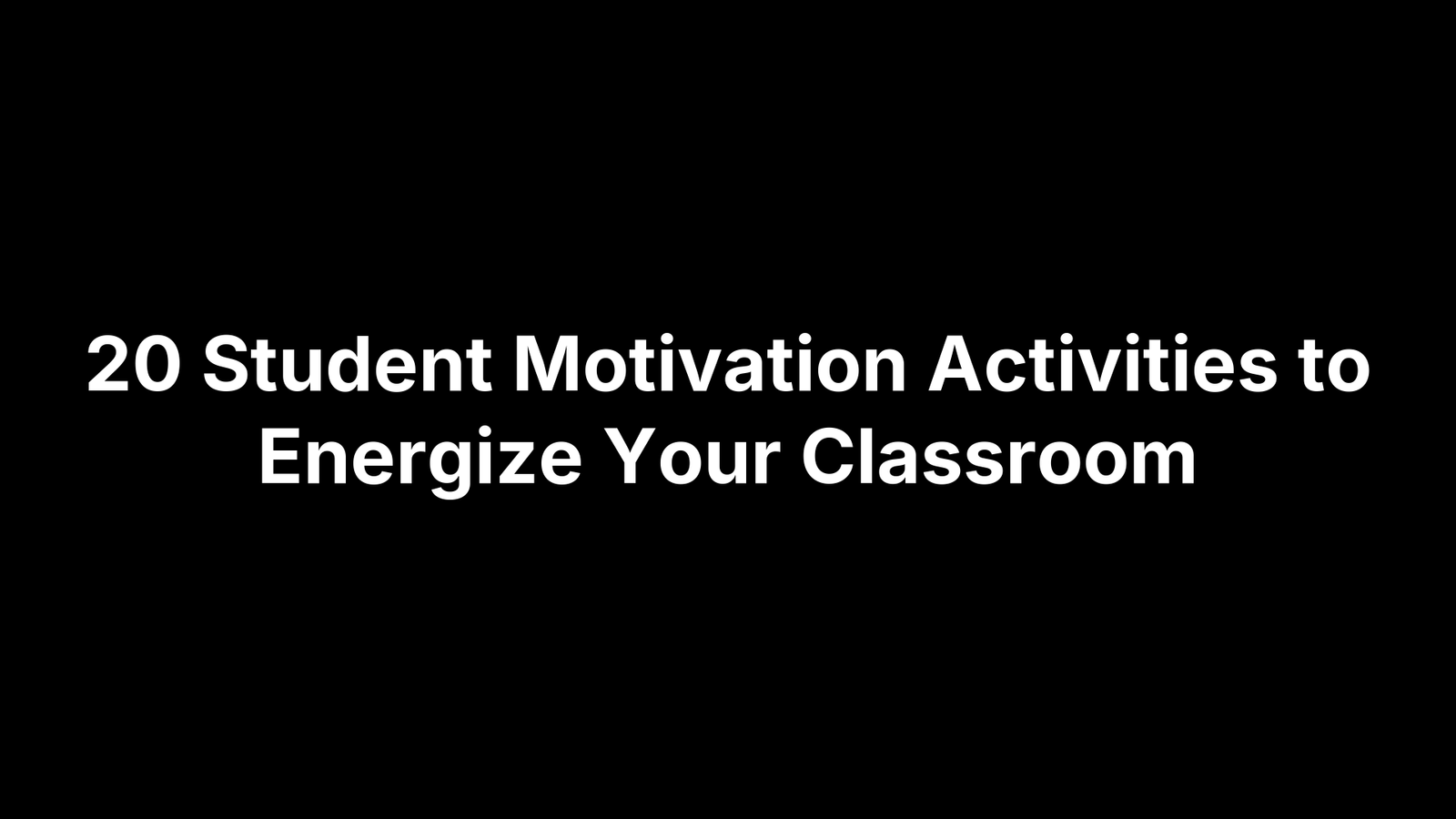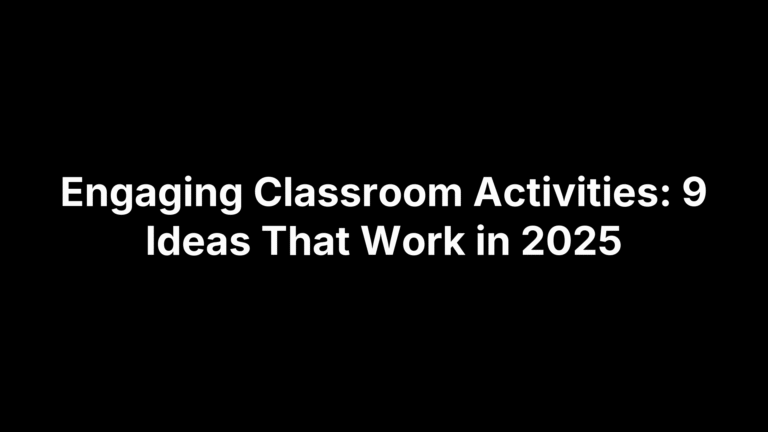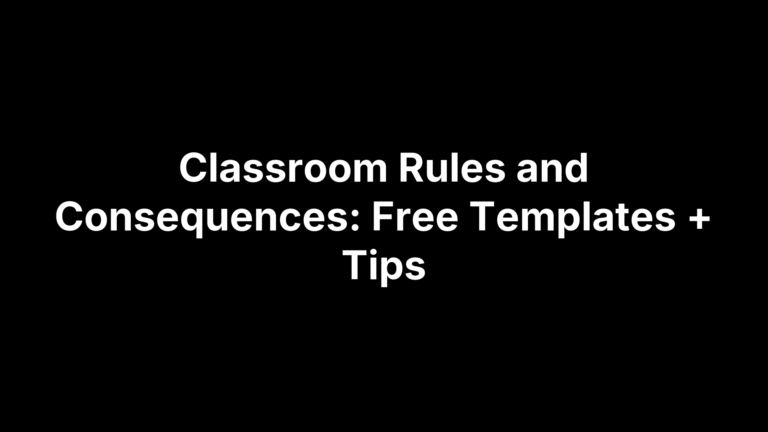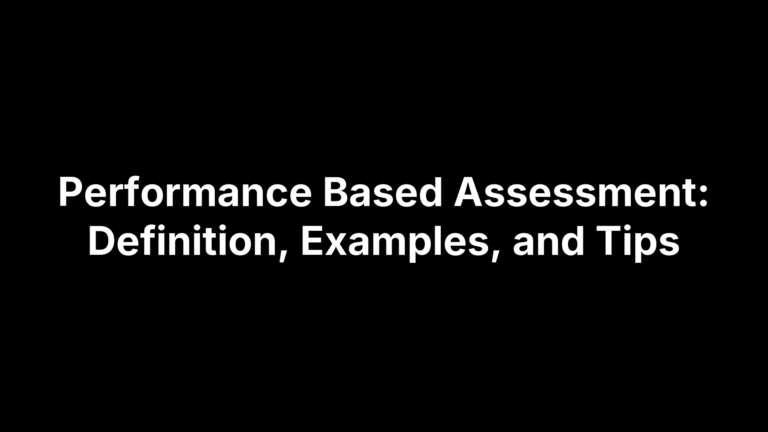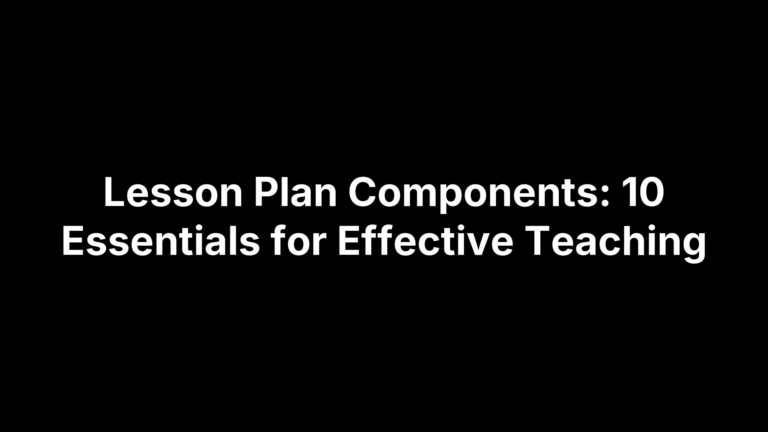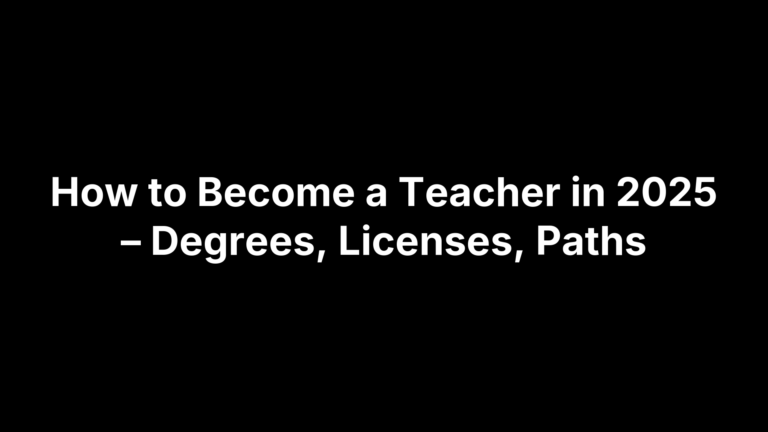20 Student Motivation Activities to Energize Your Classroom
That moment when eyes glaze over just five minutes into class can make even seasoned teachers question their calling. The good news: a small stash of ready-to-run motivation boosters can turn disengaged seats into buzzing learning hubs before the second bell rings. Whether you teach third-grade fractions, eleventh-grade literature, or anything between, the activities below have been field-tested to raise hands, lower groans, and spark genuine curiosity—without demanding hours of prep or fancy supplies.
Drawing on autonomy, competence, relatedness, and just enough novelty—the pillars researchers link to lasting engagement—each idea pairs an evidence snapshot with a no-frills, minute-by-minute playbook. You’ll find community builders, quick brain warm-ups, movement breaks, game elements, and reflection routines that mesh with any content area. Scroll, skim, or savor in order; by the end you’ll have a menu of 20 classroom-tested motivation activities and the confidence to choose the right one for tomorrow’s lesson.
For every activity you’ll see a quick ‘Why It Works’ summary followed by ‘Step-by-Step Implementation’ with timing, materials, and differentiation tweaks for elementary, middle, and high school learners of varying readiness.
1. Morning Sharing Circle
Kick-start the day by gathering students shoulder-to-shoulder in a literal circle and a figurative community. This five-to-ten-minute ritual tells every learner, “Your voice belongs here,” before textbooks even open.
Why It Works
- Shared airtime nurtures relatedness—one of the three basic needs identified by Self-Determination Theory.
- Verbalizing emotions lowers the affective filter and primes brains for new input.
- Active listening norms build empathy students later apply in pairs and group projects.
Step-by-Step Implementation
- Arrange chairs in a complete circle; hand the first speaker a bright “talking piece.”
- Post a simple prompt: weekend win, current mood emoji, or “one fact I learned yesterday.”
- Speakers get 60–90 seconds each while classmates practice silent, attentive listening.
- Provide sentence starters or picture cards for shy, ELL, or neurodivergent students; allow typed responses on Padlet in virtual settings.
- Conclude within 10 minutes by thanking participants and connecting one comment to the day’s lesson focus.
2. Daily Brain-Teaser Kickoff
Nothing jump-starts sleepy neurons like a “What am I?” riddle or pattern puzzle flashing on the screen as students file in. This two-to-three-minute ritual cues brains that class equals challenge and fun—a microdose of curiosity that carries into the main lesson. Among all student motivation activities, it’s a crowd-pleaser that scales from multiplication facts to Shakespeare quotes with zero extra copies.
Why It Works
- Solving a moderately tough puzzle releases dopamine, boosting focus and perseverance for tasks that follow.
- A predictable opener builds psychological safety while still delivering novelty through varied puzzle types.
Step-by-Step Implementation
- Post a riddle, math sequence, or lateral-thinking image on the board or LMS before the bell.
- Give 60 seconds of silent think time, then 60 seconds of pair-share to compare strategies.
- Invite one volunteer to explain the solution; spotlight multiple methods to honor diverse thinking styles.
- Offer an optional extension problem for early finishers and archive weekly winners on a “Puzzle Hall of Fame” wall.
3. Video Spark and Quick-Write
A two-minute clip can do more than a thousand pep talks—motion, sound, and story light up multiple sensory pathways at once. Follow it with a bite-sized written reaction and you’ve got an instant hook that moves students from passive watching to active meaning-making, no matter the subject area.
Why It Works
- Short videos provide novelty and concrete visuals, satisfying the brain’s craving for stimulation.
- Quick-writes force retrieval and personal connection, deepening encoding into long-term memory.
- The paired routine balances multimodal input with individual reflection, serving diverse learning preferences.
Step-by-Step Implementation
- Curate a 60–180-second clip (TED-Ed animation, news snippet, lab demo) that tees up today’s concept.
- Preview purpose: “As you watch, jot one surprise or prediction.”
- Roll the video; keep lights dim to minimize side chatter.
- Immediately set a two-minute timer for a 50-word quick-write on reaction, question, or forecast.
- Pair and share for one minute, then invite two volunteers to read standout lines that segue into the main lesson.
- Differentiate: allow voice-typing, sentence stems, or sketch notes; supply captions for accessibility.
4. “Debate Duel” Lightning Rounds
Turn hot takes into higher-order thinking with a rapid-fire debate game that needs only a timer and a provocative statement. In five minutes flat, even quiet students get a chance to flex their persuasive muscles, while your extroverts learn brevity and structure. Because topics can be lifted straight from today’s lesson—“Is a square really a rectangle?” or “Should characters in dystopian novels rebel?”—the activity dovetails with content review as well as the broader goal of energizing students through varied student motivation activities.
Why It Works
- Combines autonomy (students pick a side) with healthy competition, two proven engagement drivers.
- The 60-second limit forces concise reasoning, mirroring real-world elevator pitches.
- Peer judging adds instant feedback and a sense of audience, boosting accountability.
Step-by-Step Implementation
- Post a debatable claim and give 60 seconds of silent prep; allow graphic organizers for support.
- Randomly select two speakers (or teams) for 60-second opening arguments.
- Opponents get 30 seconds each for rebuttal.
- Three peer judges score 1–5 on clarity and evidence; record tallies publicly.
- Rotate roles so every student speaks or judges within two rounds.
- Differentiation: supply sentence stems, allow duo presentations, or run a fishbowl where observers later summarize strongest points.
5. Writing Prompt of the Day
A five-minute free-write at the start—or close—of class gives students an easy win they can point to before the period even ends. Because prompts range from silly hypotheticals (“If gravity quit for 10 minutes…”) to reflective SEL check-ins, you can match them to any unit or mood without printing a thing. Over time, the growing stack of entries becomes visible proof of progress, a subtle yet powerful nudge that fuels other student motivation activities on your roster.
Why It Works
- Routine writing builds fluency and confidence; choice-rich prompts tap imagination and personal relevance.
- Low-stakes practice lowers anxiety, letting ideas flow without the red-pen pressure of grading.
Step-by-Step Implementation
- Project or post the prompt before students enter; give a two-minute silent read/think.
- Set a timer for five minutes—pens move the entire time, spelling and grammar off the table.
- Invite volunteers to share or run a two-minute gallery walk where peers leave sticky-note compliments.
- Extension: let students tag favorite entries for future polished pieces or digital portfolios.
6. Crossword & Word-Search Race
Turn vocabulary review into an adrenaline rush by challenging pairs to crack a crossword or word-search against the clock—a zero-prep, last-minute energy boost.
Why It Works
- Game mechanics plus ticking clock trigger dopamine, sharpening focus and grit.
- Word puzzles repeatedly expose learners to target terms, cementing spelling and meaning.
- Cooperative competition merges teamwork with clear goals, welcoming mixed ability levels.
Step-by-Step Implementation
- Use a free generator to craft a crossword or word search from current unit vocabulary; print or export PDF.
- Divide class into pairs or trios; give each group a different-colored highlighter and start a visible five-minute countdown.
- First team to finish shouts “Solved!” and hands the sheet to a preselected student checker with the answer key.
- Award micro-prizes—stickers, scoreboard points, homework passes—and briefly review any tricky clues before transitioning back to the lesson.
- Run a digital version on Gimkit or Kahoot! to include remote learners.
7. One-Minute Mindful Breather
When noise levels peak or attention lags, call a sixty-second mindful breather. A guided inhale–exhale sequence quickly calms bodies and minds, priming students for whatever demanding task comes next.
Why It Works
- Reduces stress hormones and increases prefrontal activation for focus
- Creates predictable routine that signals safety and respect
- Requires zero materials—perfect emergency reset across grade levels
Step-by-Step Implementation
- Cue students: “Feet flat, hands on desks.” Dim lights or project a calm image.
- Lead five deep breaths, counting
4-in / 4-hold / 4-outaloud. - Invite a quick head-to-toe muscle squeeze and release on the final exhale.
- Signal closure with a soft chime; students flash thumbs up/side/down to report readiness.
8. Joke of the Day Board
If you’ve ever watched an entire class lean forward to hear a corny pun, you know humor can reboot attention faster than any worksheet. A standing Joke of the Day Board keeps that spark alive with almost no teacher prep—students supply the jokes, and the resulting chuckles reset the room for learning-heavy tasks.
Why It Works
- Laughter releases dopamine, which boosts mood and memory retention.
- Rotating “Class Comedian” role builds ownership and confidence.
- Shared humor strengthens community, a core driver in student motivation activities.
Step-by-Step Implementation
- Reserve a whiteboard corner or digital slide titled “Joke of the Day.”
- Assign a different student each day as Class Comedian to post a school-appropriate joke before the bell.
- Read the joke aloud; students rate it with thumbs up/side/down—ten seconds, max.
- Archive favorites in a class Google Doc for end-of-term “Comedy Hall of Fame.”
- Differentiation: provide joke books or sentence stems for reluctant writers; allow visual memes for artistic learners.
9. Gamified “Badge Board”
Few student motivation activities spark the “I-can’t-wait-to-show-you” vibe quite like a badge system. Think of it as academic scouting: learners collect visual tokens for specific skills, attitudes, or milestones and proudly display them on a public board (physical or digital). Over time, the stickers stop being about prizes and start symbolizing genuine mastery—exactly the shift we want.
Why It Works
- Tangible micro-rewards trigger the brain’s reward circuitry, sustaining effort on long-term goals.
- A prominently posted progress map normalizes celebrating growth, not just high grades.
- Peer recognition fuels relatedness, a cornerstone of intrinsic motivation.
Step-by-Step Implementation
- Brainstorm 8–10 “power skills” tied to your curriculum: e.g., “Evidence Ninja,” “Collaboration Captain.”
- Design 1-inch icons in Google Slides; print on label paper or upload to your LMS as digital badges.
- Introduce criteria—students must submit artifacts (quiz, photo, peer rubric) as proof.
- Review submissions each Friday; award badges during a two-minute ceremony.
- Differentiate by offering tiered badges (bronze, silver, gold) so every learner sees an attainable next step.
- Refresh badge options each unit to keep novelty—and motivation—high.
10. Choice Boards for Differentiated Tasks
Picture a laminated game board that quietly says, “Pick the work that fires you up.” That’s the magic of a choice board. By laying out nine varied tasks in a simple grid, you give strugglers an entry point and high-flyers a runway—without creating 30 different lesson plans. Among the student motivation activities in this list, it’s the one that turns differentiation into a self-serve buffet.
Why It Works
- Autonomy sparks intrinsic drive; students decide how to show learning.
- Tasks can target different readiness levels, interests, and learning modalities.
- The predictable 3×3 format provides clarity, reducing decision fatigue while still feeling fresh.
Step-by-Step Implementation
- Pinpoint the unit standards and craft nine tasks that climb Bloom’s ladder—
remembertocreate. - Vary media: podcast reflection, comic strip, mini-lab, infographic, or two-paragraph critique.
- Set completion rule—“three in a row” or “earn 10 points”—to balance freedom with rigor.
- Add a blank “Design Your Own” square; approve proposals in one-minute hallway conferences.
- Post concise rubrics on each square so grading stays sane and expectations transparent for every learner.
11. Student-Generated Quizzes
Nothing flips classroom energy like handing students the teacher’s hat. Among all student motivation activities, this strategy has learners write the very quiz they—and their peers—will take on yesterday’s material, transforming passive note-takers into question curators and metacognitive detectives.
Why It Works
- Authoring questions demands retrieval and synthesis, boosting retention.
- Swapping quizzes spotlights misconceptions in real time, giving students immediate corrective feedback.
- Role reversal nurtures autonomy and competence—two pillars of Self-Determination Theory.
Step-by-Step Implementation
For virtual or blended classes, students can build quizzes in Google Forms or Kahoot.
- Divide class into teams of three; assign each a textbook section or objective.
- Give five minutes to draft five varied questions: one recall, two application, two higher-order.
- Require answer keys with brief explanations to reinforce accountable accuracy.
- Teams trade papers and take the quiz under a two-minute per-item clock.
- Return to authoring group for peer-grading; spotlight “stumper” items for whole-class discussion.
- Offer micro-rewards for most creative wording or clearest explanation to sustain friendly competition.
12. Jigsaw Expert Groups
When a text chunk or data set feels overwhelming, break it into puzzle pieces and let students become “experts” on one slice before teaching it to their peers. The Jigsaw method turns passive reading into purposeful collaboration: every learner holds information the rest of the class genuinely needs, so participation stops being optional. You’ll hear richer academic language, see fewer freeloaders, and free yourself to circulate as a coach rather than a lecturer.
Why It Works
- Creates positive interdependence—each student’s knowledge is essential to group success.
- Peer teaching requires elaboration, one of the most powerful study strategies for retention.
- Built-in accountability (mini-quiz or exit ticket) keeps quality high and discourages hitchhiking.
Step-by-Step Implementation
- Split the material into 4–5 balanced sections; assign students to temporary “expert” groups by section color or number.
- Provide graphic organizers and 8–10 minutes for experts to read, annotate, and distill key points.
- Rearrange into mixed “home” groups so every section is represented; experts teach their slice in 2-minute bursts.
- Circulate with a timer and probing questions to ensure equitable airtime.
- Conclude with a four-question individual check quiz or digital poll to verify understanding and award quick feedback.
13. Project-Based Challenge Pitch
Instead of handing students a rubric and saying “get to work,” start your next unit with a fast-paced “Shark Tank” style pitch session. Present a real problem—plastic waste on campus, a historical site needing tourism revenue, or a neighborhood lacking green space—and ask teams to sell their solution in three minutes or less. The quick pitch sparks curiosity, sets a clear purpose for the longer project that follows, and gives every learner early ownership. Because students articulate their ideas publicly before any deep research, you’ll surface misconceptions, align resources, and build natural accountability from day one—an efficient way to launch project-based learning while keeping motivation sky-high.
Why It Works
- Authentic problems boost relevance, a powerful driver in student motivation activities.
- Public pitching taps competence and relatedness; peers become the primary audience, not just the teacher.
- Early formative feedback helps teams iterate, improving final product quality and confidence.
Step-by-Step Implementation
- Introduce a driving question and success criteria (5 min).
- Form heterogeneous teams of 3–4; give each a one-page planning sheet (2 min).
- Provide 15 minutes for rapid research, sketching, and role assignment.
- Teams deliver a three-minute pitch; classmates use a simple feedback grid—“Wow, Wonder, Wish” (1 min per team).
- Facilitate a quick debrief: identify common strengths, clarify misconceptions (5 min).
- Differentiation: supply sentence stems or visual templates for ELLs; allow video pitches for shy speakers; extension option—teams prototype one feature within 48 hours.
14. Reading Marathon with Progress Tracker
Turn sustained silent reading into a team sport by framing it as a “marathon.” Instead of tallying laps, the class chases a shared page or minute goal posted on a giant thermometer chart (or Google Sheet for 1:1 classrooms). Each entry logged nudges the marker higher, giving even reluctant readers a visual reminder that their ten pages matter to the collective finish line.
Why It Works
- Public progress bars tap goal-setting research: visible gains spark dopamine and persistence.
- Collective target promotes relatedness; stronger readers cheer on emerging readers.
- Regular, low-stakes practice builds reading stamina, vocabulary, and background knowledge across subjects.
Step-by-Step Implementation
- Vote on a stretch goal—e.g., “2,000 pages in four weeks”—and mark the start line.
- Hand out mini log cards; students jot pages or minutes after each independent reading block.
- At day’s end, two “data captains” total the numbers and color in the progress chart.
- Celebrate milestones (25%, 50%, 75%) with quick rewards: five-minute book talks, cozy pillow day, or a surprise “mystery reader.”
- Differentiate by allowing audiobooks or graphic novels; track minutes instead of pages for diverse text formats and reading speeds.
15. Classroom Escape Room / Digital Breakout
When you announce, “The classroom is locked and the clock is ticking,” even your most disengaged students suddenly lean in. An escape room marries narrative, mystery, and content review into a single, high-octane lesson that feels more Fortnite than formative assessment. Better yet, it scales: swap physical padlocks for Google Form “locks” and you have a zero-paper digital breakout perfect for blended or remote classes.
Why It Works
- Storyline + countdown inject adrenaline, heightening focus and persistence.
- Puzzles demand application of prior knowledge, turning review into authentic problem-solving.
- Collaboration norms (divide tasks, communicate quickly) build social skills and collective efficacy.
Step-by-Step Implementation
- Map 4–6 standards-aligned puzzles—cipher, hidden equation, primary-source photo, etc.—each yielding a code word or number.
- For a physical room, hide clues in envelopes or boxes secured with cheap combination locks; for digital, use Google Forms with response-validation.
- Introduce the scenario (“The lab virus will spread in 30 minutes”) and display a visible timer.
- Assign roles: clue runner, decoder, recorder, timekeeper, ensuring every student has a mission.
- Circulate as Game Master—offer one hint per team after 10 minutes to prevent frustration.
- Finish with a 5-minute debrief: Which strategy cracked the hardest lock? How did content knowledge help? Collect quick reflection slips for formative data.
16. Peer-Teaching Mini-Lessons
Putting students in the teacher’s seat for a brisk, five-minute lesson on a micro-topic instantly flips engagement. From math proofs to character symbolism, peers learn from peers while you circulate as coach and cheerleader.
Why It Works
- Explaining content out loud demands synthesis, the peak of Bloom’s.
- Spotlighting student voices boosts confidence and belonging.
- Rapid peer feedback surfaces misconceptions long before the test.
Step-by-Step Implementation
- Publish a menu of bite-size subtopics; pairs claim one first-come, first-served.
- Hand each pair a three-item rubric—accuracy, engagement hook, ≤5-minute pacing.
- Provide 15 minutes (or homework) to assemble slides, props, or a two-question quiz.
- Schedule five mini-lessons per day; project a big countdown to safeguard timing.
- Listeners record one “Glow” and one “Grow”; collect slips as instant formative data.
17. Goal-Setting and Progress Journals
Hand students a slim notebook (or a locked Google Doc) and watch them turn nebulous wishes into trackable targets. Five minutes a week is all it takes for learners to articulate what they want, map out baby steps, and notice their own growth—an intrinsic motivator more potent than any sticker chart.
Why It Works
- Personal goals anchor effort to something students actually care about, boosting persistence.
- Writing and revisiting goals promotes metacognition; learners see the cause-and-effect between strategies and outcomes.
- Visible progress taps the brain’s reward circuitry, releasing dopamine each time a milestone is crossed.
Step-by-Step Implementation
- Teach the SMART framework (Specific, Measurable, Achievable, Relevant, Time-bound) with quick examples.
- Allocate weekly “Focus Friday” time: 2 minutes to review last week, 3 minutes to set one new academic or SEL goal.
- Students jot next steps and select a progress metric (percent correct, pages read, minutes on task).
- Conduct bi-weekly two-minute conferences or audio comments to celebrate wins and troubleshoot barriers.
- Differentiate with sentence stems, icon stickers for early readers, or voice notes for students who struggle with writing.
18. “Simon Says” Academic Energizer
When yawns ripple through the room, launch a two-minute academic “Simon Says.” Students jump, gesture, and shout answers—reviving energy before shifting back to focused seatwork.
Why It Works
- Movement boosts oxygen and glucose to the brain in seconds.
- Game structure plus instant feedback releases dopamine for attention.
- Academic commands embed quick retrieval practice for all learners.
Step-by-Step Implementation
- Draft 6–8 content commands: “Simon says graph a quadratic,” “Simon says point to an obtuse angle.”
- Choose a student caller; switch daily for leadership credit.
- Entire class stands; act only when the phrase begins with “Simon says.”
- Wrong move? Quick desk-side squat, then pop back in—no elimination to keep everyone involved.
- After about 15 commands, debrief with one rapid-fire content question to cement learning.
19. Mystery Picture Puzzles & Guessing Games
Cue suspense and sharpen inference skills by unveiling a zoomed-in, pixelated, or blurred image tied to the day’s concept. Learners fire yes/no questions, debate possibilities, and squeal when the mystery finally clicks—turning idle minutes into high-energy, student-led discovery.
Why It Works
- The curiosity gap triggers dopamine and keeps eyes on the prize.
- Formulating strategic yes/no questions builds inference and deductive reasoning muscles.
- Takes almost no prep; one photo scales from Grade 3 to AP with deeper clues.
Step-by-Step Implementation
- Choose or crop an image linked to tomorrow’s topic; obscure with 20–25 pixelation squares.
- Project the first scrambled slide; set a one-minute timer for silent observation.
- Invite students to ask up to ten yes/no questions.
- After every two questions, remove a layer of blur or zoom out another notch.
- Winner explains reasoning; extend by assigning homework to craft tomorrow’s puzzle. Differentiate with a word bank or drawing option.
20. Reflective Exit Tickets
Wrap things up the same way elite coaches end practice—by asking players what clicked and what still hurts. A 60-second exit ticket nudges students to process the day’s learning while the information is still warm, giving you instant intel for tomorrow’s plan and adding a metacognitive punch to your arsenal of student motivation activities.
Why It Works
- Reflection turns passive exposure into active consolidation, boosting long-term retention.
- Quick, anonymous feedback signals that student voices shape instruction, increasing buy-in.
- Visible patterns (muddiest point, aha moment) guide targeted reteaching, preventing snowballing confusion.
Step-by-Step Implementation
- Post a prompt as the bell warning sounds: “One concept I can teach a friend,” “One question I still have,” or emoji confidence scale.
- Distribute sticky notes or share a one-question Google Form; limit responses to 20–30 words.
- Collect on the way out; glance for trends during passing period and sort into “re-teach,” “extend,” or “all good” piles.
- Start the next class by addressing top themes—students see their feedback matters, closing the motivation loop.
Bring Fresh Energy Every Day
A motivated class isn’t the result of one spectacular lesson but of small, consistent choices that honor curiosity, autonomy, and community. Treat the 20 student motivation activities above like a playlist: some tracks pump up energy at the start, others calm the room after lunch, and a few close the period on a reflective note. Rotate genres to keep novelty alive, yet keep the rhythm predictable enough that students feel safe taking intellectual risks. Over time, learners connect the dots—your classroom is a place where their effort, ideas, and laughter matter.
Start simple. Pick two or three favorites that fit tomorrow’s objective and test-drive them for a week. Gather quick feedback, tweak the timing, and add another activity when the first ones run smoothly. This slow-and-steady rollout prevents overwhelm for you and sensory overload for students, while still building a robust toolkit you can grab in any teaching pinch.
Ready for even more time-saving ideas, AI-powered tools, and adaptable resources? Swing by The Cautiously Optimistic Teacher and keep the motivation momentum rolling all year long.
